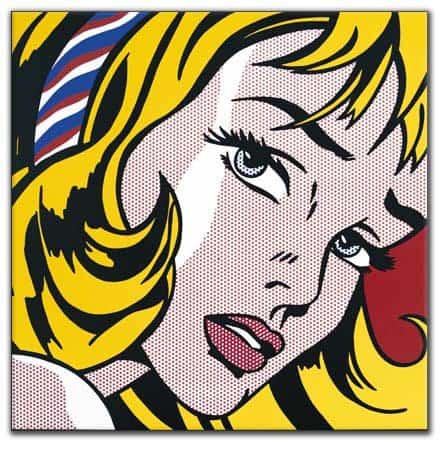
27 Sep How did Pop Art get so …Pop-ular? – Be Surprised By These 5 Pop Art Creations
The Pop art movement was largely a British and American cultural phenomenon of the late 1950s and the ’60s and was named by the art critic Lawrence Alloway in reference to the prosaic iconography of its painting and sculpture. Made famous through work of artists such as Roy Lichtenstein, Andy Warhol, Claes Oldenburg, James Rosenquist, pop art is characterised by their portrayal of any and all aspects of popular culture that had a powerful impact on contemporary life. Their iconography, taken from television, comic books, movie magazines, and advertising commercials was presented emphatically and objectively, without praise or condemnation but with overwhelming immediacy, and by means of the precise commercial techniques used by the media which inspired iconography.
What’s more, pop art represented an attempt to return to a more objective, universally acceptable form of art after the dominance in both the United States and Europe of the highly personal Abstract Expressionism. It was also iconoclastic, rejecting both the supremacy of the “high art” of the past and the pretensions of other contemporary avant-garde art. Pop art became a cultural event because of its close reflection of a particular social situation and because its easily comprehensible images were immediately exploited by the mass media. Although the critics of Pop art described it as vulgar, sensational, non-aesthetic, and a joke, its proponents saw it as an art that was democratic and nondiscriminatory, bringing together both connoisseurs and untrained viewers.

Signature Creations- The Manifestation of Pop Art
ANDY WARHOL, 32 SOUP CANS and TURQUOISE MARILYN (1962)
Andy Warhol was an American artist, film director, and producer who was a leading figure in the visual art movement known as pop art. His works explore the relationship between artistic expression, advertising, and celebrity culture that flourished by the 1960s, and span a variety of media, including painting, , photography, film, and sculpture.
In 1962, he first explored his well-known “soup can” motif. 32 Soup Cans is composed of 32 hand-painted and hand-stamped canvases, each depicting a different flavour of Campbell’s Soup. Warhol chose this subject matter because it captured Pop Art’s focus on mass production and his own artistic interest in repetition. The following year, Warhol integrated silkscreen printing into his work and painted famous portraits of American starts such as Marilyn Monroe, Elvis Presley and Natalie Wood.
The famous Marilyn Diptych, also known as Turquoise Marilyn created by Warhol was greatly inspired from his silkscreen paintings. The artwork was finished during the period of 1962; Marilyn Monroe’s death weeks and were based on solely an individual publicity photograph derived from the film Niagara (1954). Given that Warhol was extremely fond of celebrities and timeless artworks, his most highly priced paintings involved famous female celebrities. By contemplating his signature silkscreen paintings to sketch over many female faces’ iconic features, Warhol was ultimately responsible for the immense popularity of these stars even during death. According to Warhol, ‘’ With silkscreening you pick a photograph, blow it up, transfer it in glue onto silk, and then roll ink across it so the ink goes through the silk but not through the glue. That way you get the same image, slightly different each time’’.
Undoubtedly, Warhol’s Turquoise Marilyn epitomized all things pop art, especially with its unequivocal reference to Marilyn Monroe, who was known as the queen of pop culture. Pop art commenced its London movement largely because of an independent cluster of artists who fancied advertisements that depicted American materialism and mass culture. Similarly, the complete idea of mass culture, be it dance, music or ads became the British pop art’s primary subject. For all we know, Warhol’s Turquoise Marilyn would have hence not existed without British pop art inspiration.
Check out the Premium Artbox for Turquoise Marilyn by Andy Warhol here
ROY LINCHESTEIN, GIRL WITH A BALL (1961)
In 1961, American pop artist Roy Lichtenstein painted Girl With a Ball, an oil canvas pop art which now lives in the collection of the Museum of Modern Art, once being owned for numerous decades by Philip Johnson. Lichtenstein’s idea of this painting, which was one of his earliest pop culture works, was surprisingly inspired by an image he took from a hotel advertisement in Pennsylvania’s Pocono Mountains, which by the way was still running in newspapers after more than 20 years of Lichtenstein’s artwork. Through its piration, however, he renovated the photographic image by incorporating a painter’s version of comic-strip artist techniques and Ben-Day primary dot colours. Lichtenstein referred to this process as extending the ‘’limitations of mechanical reproduction’’ to wear off a polished photograph in its intense form. The result of these modifications led to a transformed Girl With a Ball, a more doll-like female, amplifying the message of fun in the sun represented by her bathing suit and red striped beach ball the same colour as her tongue and lips.
Explore the Girl with Ball Premium Artbox here
Through its years, the painting gained massive popularity and even appeared in Newsweek’s 1962 reviews as ‘’one of the most common tropes of the day for a woman’s image’’ as well as a trendy depiction of a symbolic value of ‘’iconoclastic female figures’’ including Picasso’s Les Demoiselles d’Avignon 1907 and Manet’s Olympia, 1983. Finally, Diane Waldman highly praised Girl With a Ball for being so simple yet bold in that it was able to uniquely represent a vacation atmosphere!
ROY LICHTENSTEIN, WHAAM! (1963)
Known for his colourful, comic-book-inspired paintings, artist Roy Lichtenstein put an animated and energetic spin on Pop Art. Whaam!, one of his most well-known compositions, adapts a scene from All American Men of War, a popular series published by DC comics from 1956 to 1966.

Reminiscent of an open comic book, Whaam! is rendered on 2 panels. On the left side of the diptych, an aircraft shoots another plane, which—along with the exclamation “WHAAM!”—takes up the entire right side of the piece. While the composition is strikingly similar to the original depiction, Lichtenstein changed several details; he altered the aircrafts’ designs and omitted a speech bubble. These small changes speak to Lichtenstein’s larger objective, which was to personalize these mass-produced works of art.
ROY LICHTENSTEIN, M-MAYBE (1965)
Lichtenstein’s pop art work frequently depicted glamorous women nestling in city lives, and M-Maybe is most definitely one of the very famous examples of that. Lichtenstein, like so many others was an artist who would find a certain colour scheme and use it repetitively over an extended time period by incorporating benday dots, shadows and skin tones. While glamorous women would be often considered vulnerable, the lady in M-Maybe was shown to stand up for her lover and formed reasons in her own mind regarding his absence. Lichtenstein loved creating scenarios that would leave the viewer wondering ‘’was their relationship in jeopardy’’ or ‘’where was her lover’’. In this regard, Roy’s method of telling stories without succeeding them through was a distinctive idea that added further interest in pop art culture and Lichtenstein’s career. Lichtenstein desired that his art work looked extremely mechanical, even though he was a painter. Instead of selecting matters from individuals’ photographs, he picked action and teen comics, such as the obvious source for M-Maybe so as to add a personal element of style.
Discover M-Maybe by Roy Lichtenstein Premium Artbox here
The private tenors of the words in this painting intensifies its aura’s authenticity, like verbal snapshots; a point especially apparent in the hesitant tone of ‘’M-Maybe’’. Nonetheless, Lichtenstein romanticizes its appearance with graphic tension which then separates the apparent depiction poise from that of the emotional subject matter. The integrity of the M-Maybe painting is definitely influenced from the art work’s quality itself, and also the vast number of top quality prints that ensured its stability.
DAVID HOCKNEY, A BIGGER SPLASH (1967)
David Hockney is one of the most popular and widely recognized artists of our time known for his bold, colourful and innovative art.
In the mid 1960’s, he revisited a unique subject in his popular culture-inspired paintings: the swimming pool. Inspired by a trip to California, he enjoyed the clean lines, modern aesthetic, and suburban popularity of the fixtures.
In the spring of 1967, he completed his most well-known pool painting: A Bigger Splash. Featuring only a modernist home, a folding chair, and 2 palm trees in the background, the piece’s focal point is the pool. A simplistic diving board hovers above the sleek surface of the water, which is obstructed by a splash. This subject matter, along with the colour palette and graphic aesthetic of the composition evoke the interests explored by Hockey and his fellow Pop artists during the period. He used acrylic paint on white cotton duck canvas to paint A Bigger Splash and was one of the first artists to make extensive use of acrylic.
LEGACY
Pop art found critical acceptance as a form of art suited to the highly technological, mass-media-oriented society of Western countries. Although the public did not initially take it seriously, by the end of the 20th century it had become one of the most recognised art movements. Fast forward to 2020, almost 60 years after the birth of the pop art movement, we are still celebrating and thriving in pop art. It has most definitely left its mark on modern artworks, advertising and design. For fashion, pop art fabrics continue to inspire contemporary designers, as well as pop art furniture- which correspond to a similar medium of bright colours and rigid shapes. We still continue to see tributes, homages and exhibits of original pop art works worldwide, notably at the Museum of Modern Art. They are essentially shrines to the pop art movement and guides to thousands of pieces under the banner.






